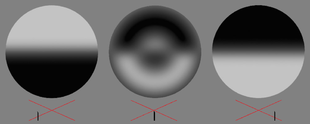Foucault's cutting method
The Foucault cutting edge method is a test method for imaging , optical surfaces. It is also suitable for analyzing the quality of complete optical systems and is used in astrophotography to focus the observation instrument. It was developed by Léon Foucault in 1856 .
The test method is also known as the knife edge method , knife edge method , Foucault test and other similar names.
The Foucault cutting method is extremely sensitive. It requires little technical effort and immediately enables a qualitative statement about the optics to be examined, whereby the smallest deviations from the ideal shape can be seen directly and with the naked eye. The quantitative values of the deviations can be determined with an accuracy of a few nanometers using various calculation methods .
Application of the cutting edge method using the example of a spherical mirror
The test is best done in a darkened room. A very sharp edge (knife edge, razor blade) and an artificial star are required as aids. The cutting edge should be able to be positioned as sensitively as possible (with some caution, some modeling clay is suitable for this). The artificial star consists of a tiny hole (pin prick) in an opaque film (aluminum or brass) that is illuminated by a bright lamp. For reasons of space, it is beneficial to place a small deflecting mirror in front of the artificial star.
The artificial star is positioned roughly in the center of curvature of the mirror (twice the focal length of the mirror). The mirror images the artificial star again near this point. The cutting edge must now be placed exactly on this illustration. A visual check of this position is easily possible. One eye must be positioned behind the cutting edge so that all light from the mirror can fall into the pupil.
The mirror then appears as a light surface that is partially covered by the cutting edge. If the cutting edge is too far towards the mirror, the side of the mirror on which the cutting edge is actually located is darkened. However, if the cutting edge is too close to the eye, the other side of the mirror is darkened. If the cutting edge is shifted so far that it just covers the image of the artificial star, the edge of the cutting edge can no longer be seen. Instead, the mirror appears a little darker over the entire surface. Only those parts of the mirror that deviate from the ideal shape appear either lighter or even darker, like a relief illuminated from the side. The spherical shape of the mirror is not visible because the image only shows the deviations from the sphere and not the sphere itself.
As is clear from the example of the spherical mirror, the Foucault cutting process is based on the fact that all light that comes from a point light source is collected again in one point. Only light rays that come from a defective part of the surface of the test object do not pass through this point and can therefore get past the cutting edge into the eye.
Testing of other types of optical surfaces
Additional optics are required as an aid for testing objectives , individual lenses or parabolic mirrors. This ensures that the light from the artificial star is transformed into parallel light and then combined by the test object in its focus . Such auxiliary optics must of course have a perfect shape so that their errors do not falsify the test results.
The autocollimation method is also suitable for lens optics . A plane mirror is placed behind the test object so that the light crosses the test object a second time before it is concentrated in one point again.
Testing astronomical instruments on a bright star
A bright star in the sky is of course also suitable as a test device. The cutting edge can be attached to an eyepiece barrel. A special testing approach, which is often called the Foucault tester , is also useful. If such a plug-on attachment for an observation instrument is designed in such a way that its length is matched to a specific photo camera and the camera and test attachment have the same connections, the test attachment can also serve as a focusing aid for astrophotography.
literature
- DD Maksutov : Technology of Astronomical Optics . VEB Verlag Technik, Berlin 1954, pp. 131-160
Web links
- Animation of the Foucault sensor
- Foucault Tester ( Memento from June 29, 1998 in the Internet Archive ) (English)


